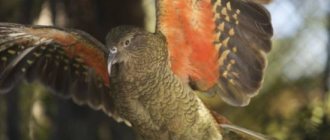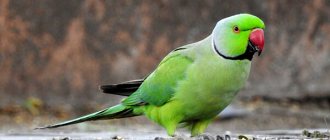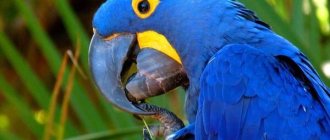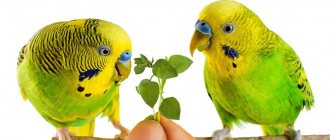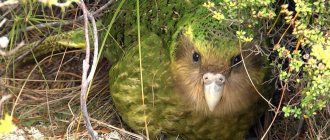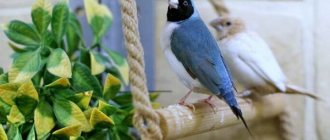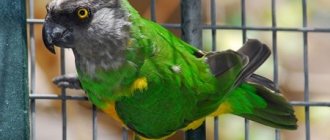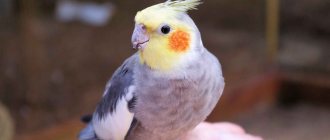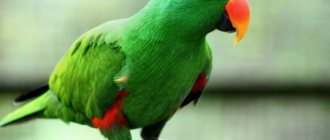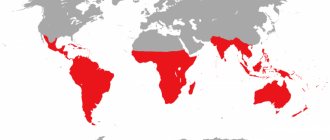In the mountains of New Zealand lives a unique bird - the kea parrot. Its scientific name is nestor (from the Latin Nestor notabilis). Local residents gave him the nickname “Sheep killer,” that is, “sheep killer.” What is this connected with, and why did Nestor get a bad reputation? After reading the article, you will find the answers and also get an idea about the appearance, lifestyle and habits of the parrot. In addition, you will learn about the reproductive characteristics and conservation status of kea.
Appearance of a parrot
| Name | Species New Zealand kakarik parrot Cyanoramphus malherbi (Latin name given in honor of the French scientist A. Malherbe) |
| Synonyms | Orange-faced, alpine, jumping. |
| Length | 0.23-0.26 m |
| Adult weight | 0.08-0.09 kg |
| Color | The main background is green with a metallic sheen, with minor shades depending on the subspecies. |
| Beak | Blue color |
| Eyes | Small, dark |
| Wings | 11-12 cm |
| Body type | Dense, knocked down |
| Tail | Reaches 11 cm in length |
| Sexual dimorphism | Males are larger, with a massive head and a large beak, and are more cocky in character. Females are small and calm. |
Other meanings of this word:
Random riddle:
Thunder rumbles, the earth shakes, someone is in the bushes.
Random joke:
- It’s scary to even think about it! - the woman said and thought bravely.
Did you know?
Europeans touch each other more often than Americans. So, in restaurants and public places they touch each other on average 100 times per hour, while Americans touch each other only 2 or 3 times during the same time.
Scanwords, crosswords, sudoku, keywords online
Good evening! Hello, dear ladies and gentlemen! Friday! The capital show “Field of Miracles” is on air! And as usual, to the applause of the audience, I invite three players into the studio. And here is the task for this tour:
Question: a “numb” parrot. (The word consists of 6 letters)
Answer: Kakapo (6 letters)
If this answer does not apply, please use the search form. We will try to find 141,989 words among 1,126,642 formulations.
The last letter in the letter is "o"
Answer for the question ""stupid" parrot", 6 letters: kakapo
Alternative crossword questions for the word kakapo
Parrot that can't fly
The only flightless parrot
New Zealand flightless parrot
Poorly flying parrot N. Zealand
New Zealand parrot
Definition of the word kakapo in dictionaries
Wikipedia Meaning of the word in the Wikipedia dictionary Kakapo, or owl parrot, is a nocturnal flightless bird from the family Nestoridae, endemic to New Zealand. The plumage is yellow-green with black speckles, has a characteristic sensitive facial disc, vibrissae-shaped feathers, and large gray.
Examples of the use of the word kakapo in literature.
After all, the kakapo is not only one of the rarest, but also one of the most distinctive birds in New Zealand, and although I dreamed of seeing a kakapo, it seemed impossible to me.
Would you like to say,” I continued, “that you have a kakapo in your poultry house and that you have been silent about it until now?”
In the wild, kakapo trample small paths in the grass during their night excursions, and from above, the area where they live seems completely lined with intersecting country roads.
Probably the only hope of salvation for takahe and kakapo lies in such reserves, and the more of them there are in the world, the better.
The kakapo is also called the owl parrot - a very apt name, because it looks so much like an owl that even an experienced ornithologist can be forgiven for making a mistake at first glance.
Source: Maxim Moshkov library
Varieties of New Zealand parrot
Initially, scientists knew about 7 species of Jumping Parrots. But by the middle of the 19th century, three subspecies became extinct. The rest are now under the protection of environmental organizations as endangered or sharply declining populations.
The main reasons for extinction and population decline:
- deforestation;
- introduction of predatory animal species to the islands;
- poachers.
| Kakarikov subspecies | Peculiarities | Photo |
| Red-fronted | The presence of a red stripe or red spots on the head, and blue feathers under the tail. Sometimes there are mutations with orange heads. | |
| Yellow-fronted | Yellow-orange forehead against a red cap, red blotches on the tail: Breed well in captivity. | |
| Antipodean | The sternum, belly and undertail are yellowish, and there are blue-violet areas above the wings. | |
| Mountain | The forehead and crown with a characteristic red tint: They reproduce well at home. |
Sheep hunting
By developing the land, New Zealand farmers have significantly changed the landscape. This could not but affect the parrots' nutritional system. Increasingly experiencing hunger, kea began to look for alternative types of food and at some point discovered sheep meat. Most likely, the first prey was the remains of livestock that died from disease. The birds liked the flesh so much that they began to boldly attack the sheep flocks.
Keas are very smart parrots, observant and inventive. They now have a way to herd the sheep and get plenty of food. A nestor jumps on an animal that has strayed from the herd. Holding itself on its back, it uses its beak to tear out scraps of fur, gradually reaching the skin. At first, the sheep does not suspect the danger, but, feeling pain, it runs and tries to throw off the predator. Meanwhile, Nestor pecks at the wound, swallowing the fat. From fear and fatigue, the animal loses orientation and falls into the abyss or dies from loss of blood.
On a note! Only in conditions of starvation do parrots obtain meat in this way. For the most part, kea feast on dead sheep.
Such occasional attacks on flocks of sheep did not cause significant damage, but caused a storm of indignation among farmers. Having discovered a corpse with traces of a parrot, people blamed the kea. Isolated examples of bloodthirstiness became the reason for the mass extermination of Nestors.
Features of keeping at home
Kakariki quickly adapt to home living conditions. But in order for your feathered pet to feel good, experienced poultry farmers recommend paying attention to the following points:
- Length of daylight (no more than 12 hours, otherwise the birds will start nesting).
- The presence of places where the bird can get stuck or get injured while walking (it is better to close all niches, holes, openings, and remove sharp and fragile objects from the room).
- Air temperature should be from +170C to +200C (birds become aggressive in the heat).
- Air humidity (normal 60 to 70%).
It is better to limit curious Kakariki from contact with green spaces in the house and other pets (cats, dogs).
Cell selection
The optimal size of a bird house is 0.85x0.55x0.9 m.
The bars of the cage are metal, horizontal, placed at a distance of up to 2 cm.
The shape of the bird's home is rectangular (birds will be able to run on all planes, including the ceiling).
It is better to cover the bottom of the cage with paper or pour wood filler on it (birds like to run on the floor and rummage).
Since the birds are hyperactive and are constantly exploring something, they must be allowed out every day to “walk” around the apartment for at least 4 hours a day. The health of feathered pets directly depends on such walks.
The cage should be filled with the necessary equipment - feeders, drinking bowls, toys, bathtub, perches.
Video Kakarik - All about the breed of parrots
Nutrition
Jumping parrots are not picky about their diet. The main rule is a variety of feeds. The diet of birds includes:
- juicy and soft herbs (up to 70% of the total mass) nettle or dandelion;
- vegetables, fruits (15-20%): - cucumbers; - Bulgarian pepper; - carrot; - zucchini, squash; - pumpkin; - Chinese cabbage; - celery, lettuce; - apples, pears; - apricots; - kiwi; - citrus fruits;
- grains with legumes, as well as microgreens made from them or ready-made grain mixtures (oats, wheat, buckwheat, lentils, peas, soybeans, corn, sunflower, flax seed, nuts);
- products of animal origin (eggs, cottage cheese, larvae);
- mineral supplements (sand, chalk, sepia).
The diet of Jumping Parrots in the fall must include nuts, and in the winter - microgreens from wheat or barley and vitamins.
Toys
For birds, toys that are suitable for small species of birds are suitable - balls, rings, bells, climbing frames, perches, swings. But in addition to purchased products, a variety of threads, shreds, and even wood filler or sand, in which they will happily rummage, can amuse your feathered pet. Birds' attention switches with extreme speed, so they constantly need to be offered new fun.
The presence of toys in the cage of the New Zealand Kakarika in the absence of the owner should be minimized so that the bird left alone does not accidentally get injured.
Intelligence and abilities of Kakariks
Intelligence and quick reaction are the hallmarks of jumping parrots. In addition, they perfectly remember the location of objects, quickly adapt to any changes and deftly adapt to environmental conditions. With constant communication, the Kakarik parrot remembers up to 30 words, although it speaks them without much expressiveness (word combinations with hissing sounds are better).
If you work with your feathered pet every day, he will certainly delight the audience with tricks: juggling rings, quickly (almost lightning-fast) moving around the house, rolling balls.
Education and domestication
Although New Zealand parrots are friendly to people, you should not expect them to become loyal friends in the house. Birds will make contact with humans mainly for the sake of getting a treat, and then quickly run away “on business.” To ensure that nothing disturbs your parrot during training, it is better to remove other pets from the room and try to stay alone longer. For each “success” the bird must be “rewarded” with a treat. Over time, a smart bird will grasp the connection between commands and treats, and will willingly begin to carry out assigned tasks.
Care and hygiene
Care and maintenance also require certain hygiene measures:
- daily cleaning of the bottom and replacement of filler;
- washing feeders and drinkers every day;
- carrying out general cleaning every 7-10 days;
- quarterly disinfection of the cage with equipment.
Diseases
The main reasons why parrots get sick:
- improper diet;
- unsanitary conditions of detention;
- too dry and hot air.
The most common pathologies that jumping parrots are exposed to are:
- Paratyphoid;
- Tuberculosis;
- Helminthiases;
- Knemidocoptosis;
- Hyperkeratosis;
- Mycoplasmosis;
- Food intoxication;
- Colds.
Due to their increased activity, birds are always prone to various types of injuries.
The main prevention of the occurrence of pathological conditions is maintaining cleanliness in the cage, selecting high-quality feed, periodic disinfection, feeding with vitamin and mineral premixes to strengthen the immune system.
Video of Kakariki jumping New Zealand parrots
How long do kea live and what do they eat?
Nestor does not live very long in the wild: only 15 years. The struggle for survival is more successful if birds gather in flocks. Typically, the population of a bird community does not exceed 10–15 individuals; this number is most convenient for obtaining food.
The habitat leaves its mark on the lifespan of birds. To survive, the kea uses all natural resources and turns from a herbivore to a predator. In cold weather, the expenditure of calories to heat the body increases. The nestor's diet includes any available food:
- plants (flowers, seeds, nuts, stems);
- fruits;
- insects, larvae, worms;
- eggs and chicks of other birds;
- food waste from people's tables;
- animal corpses.
Important: Previously, meat was not part of the diet for kea. Only with the advent of Europeans, who brought livestock to New Zealand, did this parrot taste sheep meat during hungry wintering periods.
Breeding at home
Due to their strong instinct for procreation, Kakariki always need a partner, so they should only be kept in pairs. Parrots become sexually mature after 3 months, but it is better to mate them no earlier than 6 months of life (after all vital organs have matured). Pairs form quite quickly, but there are times when parrots cannot find a common language with each other. It is worth noting that during puberty, birds become more aggressive, and during this period they may not get along well with everyone around them. The breeding season can last all year.
For birds, a nesting house measuring 0.25x0.25x0.40 m is set up at a height of approximately 20 cm from the bottom. The diameter of the tap hole is made approximately 6-7 cm.
Recommended microclimate indicators: — temperature — +20-+250С; — humidity – 60-80%; - daylight hours - up to 16 hours.
One clutch can contain up to 10 eggs, which the female incubates for 19-25 days. Chicks that hatch earlier have a greater chance of survival. Feathered parents jointly feed their offspring. And at the age of 2-2.5 months, the young animals are placed in a separate cage.
There should always be a bathtub near the female New Zealand parrot during incubation. By wetting its feathers, the bird is able to maintain the correct temperature of the eggs.
How to determine the gender of Kakarika
Genetic testing can accurately determine the sex of birds. But Kakariki are also characterized by quite distinct sexual characteristics:
- size – males are always distinguished by their larger torso;
- head size - in females it is two times smaller than in males;
- beak size – in males it is larger and wider;
- females have a special spot that stretches from the beak to the back of the head;
- males are characterized by increased activity;
- cornea color: in females - flesh-colored, in males - dark blue.
Matching
Selecting the right pair is the key to successful breeding of New Zealand parrots at home. To ensure that brought together birds are not just friends while living together in a cage, it is recommended:
- carefully bring the birds together so as not to quarrel from the first day (arrange short meetings for 5-10 minutes, gradually increasing the time of meetings);
- maintain the desired microclimate and increase the duration of daylight hours (more than 12 hours).
At the first signs of mating (the male takes care of the female, cleans her feathers, feeds her), the birds are left to live together and a nest is installed for them.
Video of Kakariki Ethan swearing
Character and lifestyle
Kea is an unusual, peculiar parrot. You can meet it in nature only in one place on the globe - on the South Island of New Zealand. A harsh climate reigns here: strong winds, snow drifts, fogs. Despite the difficult living conditions, the nestors have adapted perfectly and learned to take advantage of every little thing. The development of ski resorts has become a real godsend for parrots, because there is always something to eat near people.
Kea Features:
- The only predatory parrot. In normal times it feeds on insects and worms. In times of hunger, it does not disdain carrion. It also attacks living sheep if it cannot find other food.
- Lives and breeds at altitudes of up to 1500 meters above sea level. This is a unique ability that other parrots do not have.
- Attached to its habitat. It does not fly and always remains within its range, adapting to the conditions of a certain area.
- Not afraid of the cold. He loves to tumble in the snow, swim in icy puddles, and slide off snow-covered roofs.
What else is interesting about kea? He is famous for his hooligan tendencies. The curious bird is not at all afraid of humans, calmly approaches tourist centers and organizes daring attacks. Small groups of nestors attack abandoned cars, climb into open windows of houses, and manage garbage containers.
On a note! With their sharp beaks, kea parrots tear off rubber seals and remove windshield wipers from cars. The persistence of these birds is limitless: in search of food, they can open and overturn any garbage can.

